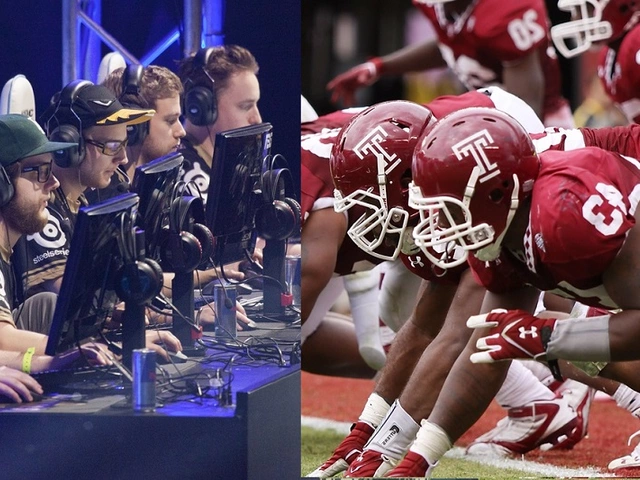Sports Statistics: Your Guide to Numbers, Trends & Diversity
When working with Sports Statistics, the collection, analysis and presentation of data that measures performance, participation and trends in sport. Also known as athletic data analytics, it helps fans, clubs and researchers make sense of the game. In Oxfordshire we see clubs using stats to track player progress, schools comparing participation rates, and journalists turning raw numbers into stories. If you’ve ever wondered why a team’s win‑loss record matters beyond the scoreboard, the answer lives in this data.
When we look at NFL player demographics, the breakdown of players by ethnicity, age and background in the National Football League, we instantly see a micro‑cosm of broader sports trends. These demographics feed directly into sports statistics, giving a factual basis for conversations about representation and talent pipelines. For example, tracking the rise of certain ethnic groups over seasons shows how scouting networks evolve.
Another key piece of the puzzle is Asian athletes, players of Asian descent who compete at professional and amateur levels across a range of sports. Their numbers may be small, but each entry adds a new data point that reshapes our understanding of global participation. When a young Asian quarterback makes the roster, it’s a statistic that sparks discussion, inspires newcomers and nudges coaches to expand their search horizons.
All of this feeds into the larger concept of diversity in sports, the inclusion of varied ethnic, gender and cultural backgrounds within athletic communities. Diversity directly influences sports statistics because a richer talent pool creates more varied performance metrics. When leagues prioritize inclusive policies, the resulting data sets become more representative, allowing analysts to spot trends that were previously hidden.
For local clubs, the practical payoff is huge. Coaches pull stats to tweak training routines, fans check player rankings before heading to the ground, and journalists turn raw numbers into headlines. By understanding how Sports Statistics intersect with demographics, ethnicity and diversity, you gain a clearer picture of why a team’s strategy evolves season after season. The same data can guide funding decisions for youth programs in Oxfordshire, ensuring resources go where they’re needed most.
What you’ll discover below
In the list that follows, you’ll find articles that dive deep into specific data stories – from the growing presence of Asian players in the NFL to how diversity metrics reshape club recruitment. Each piece unpacks a slice of the larger statistical landscape, giving you actionable insights you can use whether you’re a fan, coach or aspiring analyst.
Ready to explore the numbers that drive today’s sports scene? Scroll down and see how each story adds a fresh layer to the world of sports statistics.
How many Asians are playing in the NFL?

As an NFL enthusiast, I've noticed a gradual increase in the number of Asian players in the league over the years. Although the numbers aren't as high as other ethnic groups, the presence of Asians in the NFL is undeniably growing. This includes players of Asian descent, mixed heritage or those born in Asia. Their representation in the NFL is important as it promotes diversity in the sport. It's great to see the NFL becoming more inclusive and I look forward to seeing even more Asian players make their mark in the league.
Categories
RECENT POSTS
Gemini 2.5 Launch Escalates AI War Between Google and Microsoft in 2025
Google's Gemini 2.5 launch intensifies its AI rivalry with Microsoft Copilot, offering faster, free, multimodal AI with 1M-token context vs. Copilot's 40% Excel productivity gains and enterprise integration — setting up a 2026 showdown over privacy, price, and platform dominance.
How to Maintain Friendships With Clients Without Coming Across as Unprofessional
Learn how to build genuine, lasting relationships with clients without crossing professional boundaries. Real tips on warmth, boundaries, social media, and when to say no.
Why isn't eSports as accepted as active sports?
Hey folks, let's dive into this spicy salsa of a topic - Why isn't eSports as accepted as active sports? It's like trying to convince your grandma that your digital art is as real as her oil paintings! Well, the first hurdle is the physicality, or lack thereof. Traditional sports fans are often skeptical about watching folks play video games, missing the sweat and muscles flexing. But, let's not forget, eSports require serious mental gymnastics and finger dexterity! So next time you're defending eSports, flex those brainy biceps and remember, not all games need a ball and a field!
£11.4 Million UK Lotto Jackpot Rolldown Boosts Winners on July 26, 2025
The £11.4 million UK Lotto jackpot rolled down on July 26 2025, upping prizes for 1.6 million winners, while the Thunderball draw hit a £500,000 top prize.




